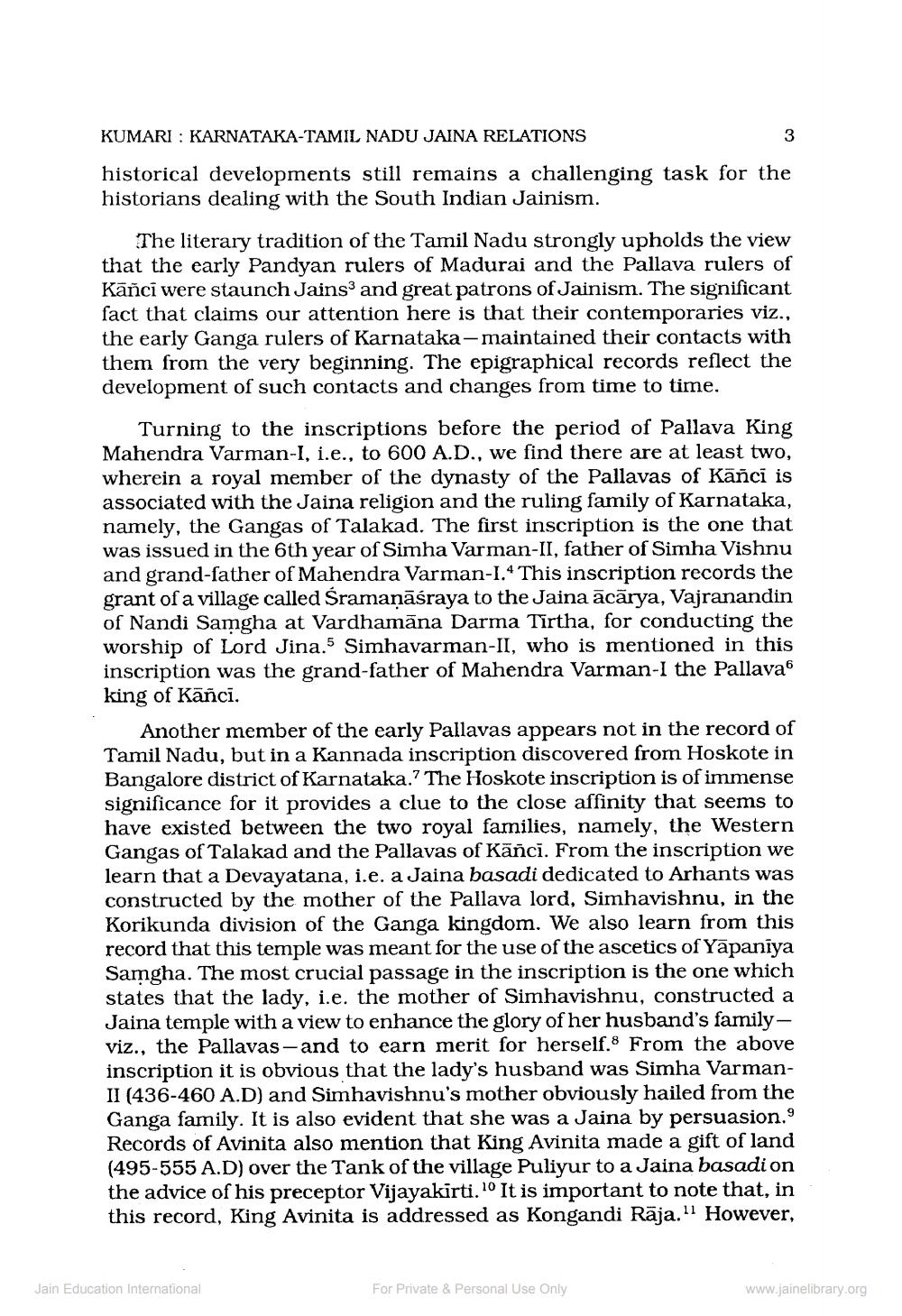Book Title: Jain Journal 1997 07 Author(s): Jain Bhawan Publication Publisher: Jain Bhawan Publication View full book textPage 8
________________ KUMARI : KARNATAKA-TAMIL NADU JAINA RELATIONS historical developments still remains a challenging task for the historians dealing with the South Indian Jainism. The literary tradition of the Tamil Nadu strongly upholds the view that the early Pandyan rulers of Madurai and the Pallava rulers of Kanci were staunch Jains, and great patrons of Jainism. The significant fact that claims our attention here is that their contemporaries viz., the early Ganga rulers of Karnataka-maintained their contacts with them from the very beginning. The epigraphical records reflect the development of such contacts and changes from time to time. Turning to the inscriptions before the period of Pallava King Mahendra Varman-I, i.e., to 600 A.D., we find there are at least two, wherein a royal member of the dynasty of the Pallavas of Kanci is associated with the Jaina religion and the ruling family of Karnataka, namely, the Gangas of Talakad. The first inscription is the one that was issued in the 6th year of Simha Varman-II, father of Simha Vishnu and grand-father of Mahendra Varman-1.4 This inscription records the grant of a village called Sramanasraya to the Jaina acarya, Vajranandin of Nandi Samgha at Vardhamana Darma Tirtha, for conducting the worship of Lord Jina.5 Simhavarman-II, who is mentioned in this inscription was the grand-father of Mahendra Varman-I the Pallava king of Kanci. Another member of the early Pallavas appears not in the record of Tamil Nadu, but in a Kannada inscription discovered from Hoskote in Bangalore district of Karnataka.? The Hoskote inscription is of immense significance for it provides a clue to the close affinity that seems to have existed between the two royal families, namely, the Western Gangas of Talakad and the Pallavas of Kanci. From the inscription we learn that a Devayatana, i.e. a Jaina basadi dedicated to Arhants was constructed by the mother of the Pallava lord, Simhavishnu, in the Korikunda division of the Ganga kingdom. We also learn from this record that this temple was meant for the use of the ascetics of Yapaniya Samgha. The most crucial passage in the inscription is the one which states that the lady, i.e. the mother of Simhavishnu, constructed a Jaina temple with a view to enhance the glory of her husband's familyviz., the Pallavas- and to earn merit for herself. From the above inscription it is obvious that the lady's husband was Simha VarmanII (436-460 A.D) and Simhavishnu's mother obviously hailed from the Ganga family. It is also evident that she was a Jaina by persuasion.9 Records of Avinita also mention that King Avinita made a gift of land (495-555 A.D) over the Tank of the village Puliyur to a Jaina basadion the advice of his preceptor Vijayakirti. 10 It is important to note that, in this record, King Avinita is addressed as Kongandi Raja." However, Jain Education International For Private & Personal Use Only www.jainelibrary.orgPage Navigation
1 ... 6 7 8 9 10 11 12 13 14 15 16 17 18 19 20 21 22 23 24 25 26 27 28 29 30 31 32 33 34 35 36 37 38 39 40 41 42 43 44 45 46 47 48 49 50
